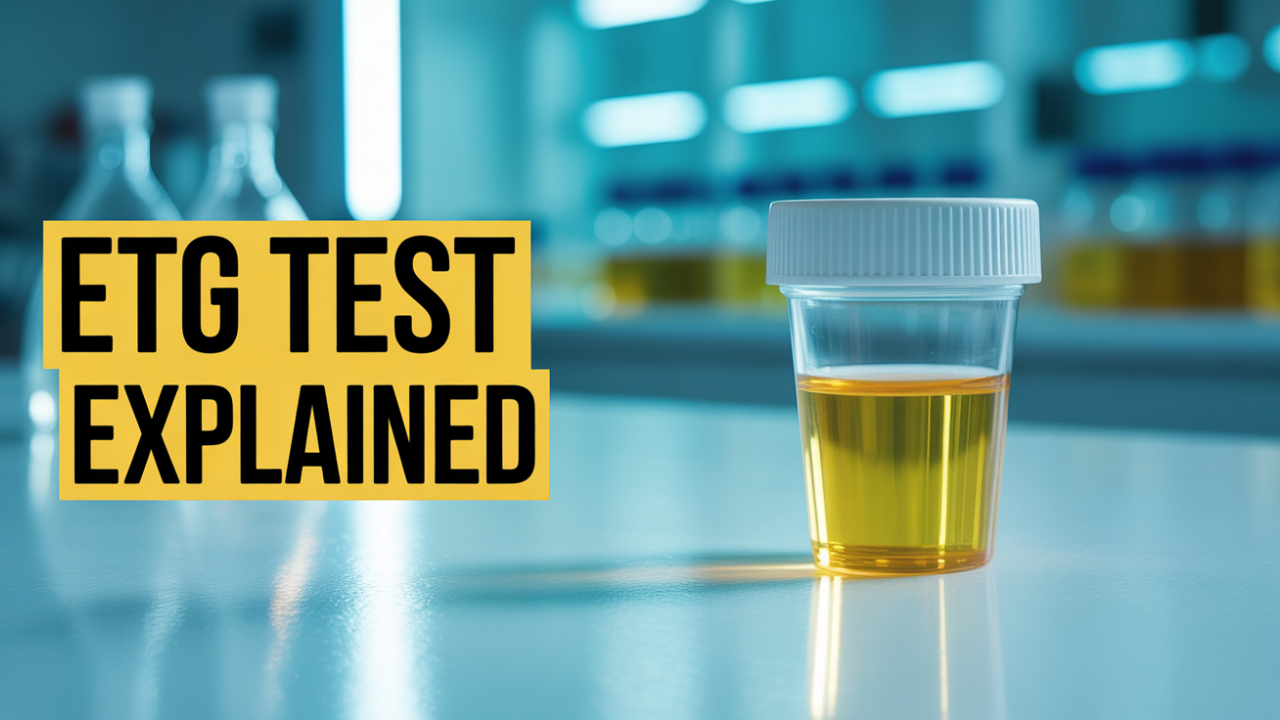Ethyl Glucuronide Test
The Ethyl Glucuronide (EtG) test is a highly sensitive method used to detect recent alcohol use. It measures a specific metabolite produced after a person consumes an alcoholic beverage. Unlike traditional blood tests or a breathalyzer, the EtG test provides a longer detection window, making it useful in addiction treatment, clinical research, and toxicology settings.
At Lynk Diagnostics, we offer certified EtG testing through our laboratory network, ensuring accuracy and reliability. Our services support treatment programs, primary care providers, and researchers seeking detailed alcohol exposure information.
What Is Ethyl Glucuronide?
Ethyl Glucuronide is a glucuronide—a type of metabolite formed when the body processes ethanol, the active ingredient in all alcoholic beverages. After someone has a drink like wine, beer, or spirits, their liver breaks down the alcohol through a series of chemical reactions known as metabolism. During this process, ethanol combines with glucuronic acid to form EtG.
EtG is water-soluble and excreted in urine, saliva, and blood, making it an effective biomarker for detecting alcohol intake. Because EtG stays in the body longer than blood alcohol content, it provides a more extended detection period than standard drug tests.
Why Use the EtG Test?
The EtG test offers crucial benefits over standard alcohol detection methods:
- It remains detectable long after ethanol is gone from the system.
- It confirms recent consumption even in the absence of intoxication.
- It supports monitoring in addiction recovery and disease management.
EtG testing is particularly valuable in settings that require proof of abstinence, such as treatment programs, court-ordered monitoring, and employer-mandated drug tests. It also helps clinicians track patients with alcohol-sensitive conditions like bipolar disorder, liver disease, and chronic kidney disease.
Sample Types and Detection Windows
EtG testing can be conducted using several sample types. The urine test is most common due to its cost-effectiveness, ease of collection, and long detection window.
- Urine: Detects alcohol for up to 80 hours after consumption.
- Blood: Useful for clinical settings; EtG lasts 24–48 hours.
- Saliva: Less sensitive and rarely used.
- Hair: Can reflect long-term exposure but is slower and more expensive.
EtG detection depends on the amount consumed, patient body weight, hydration level, kidney disease status, and metabolic rate. People who engage in binge drinking will generally have higher EtG concentration levels than those who drink moderately.
Comparing EtG to Other Alcohol Biomarkers
EtG is often used alongside other biomarkers to provide a complete picture of alcohol use. These include:
- Ethyl Sulfate (EtS): Another direct ethanol metabolite tested with EtG.
- Phosphatidylethanol (PEth): A blood marker that reflects chronic or heavy drinking.
- Carbohydrate Deficient Transferrin (CDT): Indicates long-term heavy alcohol use.
- Blood Alcohol Content (BAC): Measured by breathalyzer or blood test for recent intoxication.
Biomarker | Sample Type | Detection Window | Best Use Case |
Ethyl Glucuronide (EtG) | Urine, Hair | Up to 80 hrs (urine) | Recent alcohol use, abstinence checks |
Ethyl Sulfate (EtS) | Urine | Up to 80 hrs | Confirmation alongside EtG |
Phosphatidylethanol (PEth) | Blood | 2–3 weeks | Clinical trial, long-term monitoring |
Carbohydrate Deficient Transferrin (CDT) | Blood | 1–2 weeks | Chronic or heavy drinking |
Blood Alcohol Content (BAC) | Breath, Blood | 4–12 hours | Real-time intoxication detection |
How EtG Testing Works
The EtG assay process follows standards outlined by the Clinical Laboratory Improvement Amendments (CLIA). Initial screening uses immunoassays. Positive results are confirmed using liquid chromatography and mass spectrometry—specifically LC-MS or GC-MS.
These instruments separate EtG from other molecules in the sample and identify its unique chemical signature with high precision. Labs measure the concentration of EtG using strict thresholds to distinguish true alcohol use from low-level exposure.
What Affects EtG Levels?
Patient-Specific Variables
EtG concentration depends on the volume of alcohol consumed, how much water a person has consumed, their weight, and the efficiency of their excretion system. In patients with impaired kidney or liver function, EtG may accumulate more slowly.
Environmental and Product Exposure
Trace levels of EtG can result from non-beverage sources of ethanol such as:
- Hand sanitizer
- Mouthwash
- Fermented foods
- Liquid cold medications
- Herbal remedies
- Personal hygiene sprays
CLIA-approved laboratories account for these risks by establishing cutoff thresholds, often 100 to 500 ng/mL. These levels prevent false positives caused by incidental exposure.
Use in Treatment Programs and Health Care
EtG is a vital tool in addiction recovery. Treatment programs use it to monitor abstinence and assess patient compliance. Repeated positive tests may indicate relapse, requiring updated medicine plans or support services.
In primary care, clinicians use EtG to monitor patients with conditions affected by alcohol, such as bipolar disorder, diabetes (via glucose markers), and chronic kidney disease. EtG results inform the risk level for ongoing damage.
Legal, Employment, and Insurance Implications
Courts may order EtG testing for individuals on probation or in custody disputes. Employers in safety-sensitive fields often require drug testing that includes alcohol detection through EtG.
Insurance and Medicare
EtG testing may be covered by insurance or Medicare if medically necessary. Eligibility often depends on diagnosis codes, documented need for alcohol monitoring, or inclusion in a registered clinical trial.
Lynk Diagnostics works with both patients and providers to help determine insurance eligibility, submit claims, and minimize out-of-pocket costs.
EtG in Clinical Research and Trials
EtG is widely used in clinical trials to confirm participant-reported alcohol use. It is frequently referenced in studies listed in PubMed. Researchers use EtG to:
- Measure alcohol exposure in patients with bipolar disorder
- Evaluate treatment programs
- Study alcohol’s effect on liver pathology
- Analyze alcohol-related genetics
- Perform in vitro lab experiments involving alcohol and cell lines
Because of its reliability and extended detection window, EtG remains a cornerstone tool in clinical research.
Turnaround Time and Result Reporting
Typical turnaround time for EtG test results is 1 to 3 business days. Hair or blood testing may take longer due to sample processing and confirmatory steps like mass spectrometry.
At Lynk Diagnostics, test results are returned electronically through a secure portal. Each report includes data on the assay method used, the EtG concentration, and interpretive comments for patient care teams.
EtG vs. Breathalyzer
The breathalyzer is commonly used to measure blood alcohol content in roadside settings or immediate impairment checks. It reflects current intoxication but cannot detect alcohol consumed more than a few hours earlier.
EtG testing, however, identifies alcoholic beverage consumption up to 80 hours later. It is ideal for verifying sobriety over time, especially in treatment programs or medical settings where long-term monitoring is essential.
Diet, Medicine, and Test Accuracy
Patients should avoid liquid medications or foods that contain ethanol prior to an EtG test. These include:
- Cough syrups
- Wine-based sauces
- Soy sauce
- Herbal extracts
All of these products can affect EtG concentration and may lead to positive results. Providers should collect a full history of medicine, food, and hygiene product use before testing.
Role in Pathology and Diagnostic Care
In pathology, EtG testing supports the diagnosis of alcohol-related disease. If a patient presents with elevated transferrin, abnormal glucose, or signs of liver damage, EtG may confirm recent alcohol intake as a contributing factor.
EtG also complements findings in toxicology screens and helps assess how alcohol may interact with other drug use, especially in primary care and clinical laboratory settings.
Conclusion
The Ethyl Glucuronide test is an advanced tool that identifies alcohol use with greater sensitivity and a longer detection window than standard tests. It supports better decisions in healthcare, clinical research, legal cases, and addiction recovery.
At Lynk Diagnostics, we offer CLIA-certified EtG testing using validated chromatography and mass spectrometry methods. Our team ensures rapid turnaround time, accurate reporting, and insurance support for both providers and patients.
Whether you’re a clinician managing risk, a researcher conducting a clinical trial, or a person working to maintain abstinence, the EtG test offers the data you need to take the next step forward
FAQs
1. How long can EtG be detected after drinking alcohol?
EtG is usually detectable in urine for up to 80 hours and in blood for 24 to 48 hours. Detection length depends on consumption, metabolism, and hydration.
2. Can hand sanitizer or mouthwash cause a positive EtG test?
Yes, but only in small amounts. Labs use cutoff thresholds to prevent false positives from hygiene products or medicine that contain ethanol.
3. What’s the difference between EtG and a breathalyzer?
A breathalyzer measures immediate blood alcohol content. The EtG test detects recent use and is better for long-term monitoring or abstinence verification.
4. Will insurance or Medicare cover an EtG test?
Yes, if medically necessary. Medicare and private insurance often cover EtG tests as part of treatment programs, disease management, or routine monitoring.








